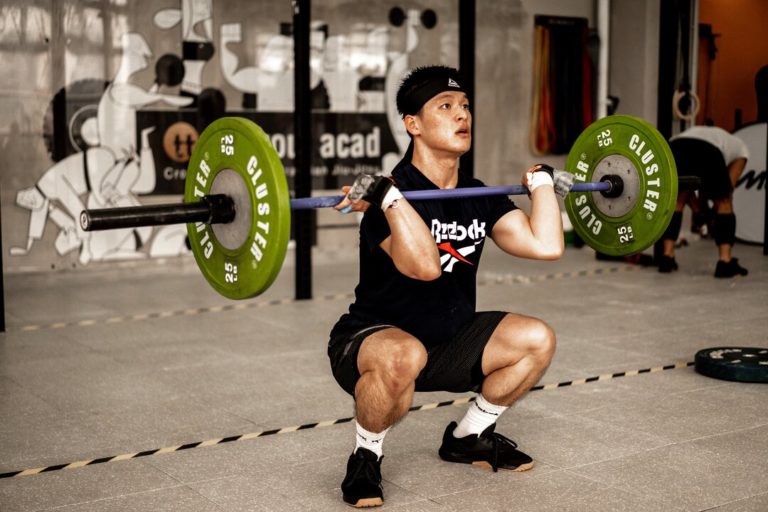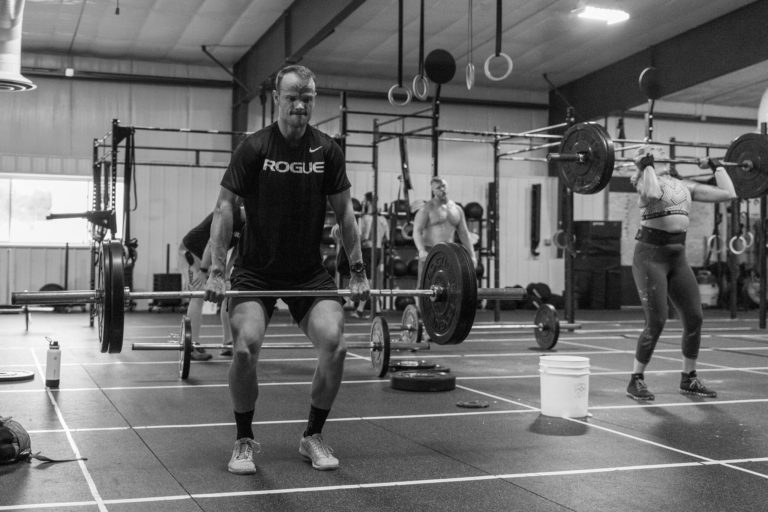The clean is used to lift a load from the ground to the shoulders, where frequently the object is being readied for lifting overhead.
The lifter goes through three phases, or pulls, when performing the clean. The first pull from the ground is a smooth positioning pull using the legs to lift the bar to just past the knees. Once the bar passes the knees, the lifter performs the second pull by aggressively “jumping” their body into the finish position with hips and legs fully extended. This rapid extension of the hips and legs creates speed and upward momentum on the bar. At this point, with the bar momentarily weightless, the final phase of the lift, or third pull, sees the lifter actively pulling their body down and around the bar, and aggressively driving the elbows forward to receive the bar on the shoulders. The full movement finishes with the hips and legs working by squatting the weight and standing up to full extension.
The speed and force required by the clean make it a potent movement with enormous fitness potential due to the high power output. There are a few variations of the clean, which can be performed at light loads by beginners as well as extremely heavy loads by experienced weightlifters.
The points of performance for the clean are:
- Hip-width stance (or the stance that allows for the most power to be produced as the lifter drives against the ground).
- Hands a thumb’s distance from hips or wider to allow for the fastest elbow turnover.
- Hook grip on the bar.
- Shoulders slightly in front of the bar at setup.
- Lumbar curve maintained.
- Hips and shoulders rise at the same rate.
- Heels down and arms straight until hips and legs fully extend.
- As the torso rotates to vertical, the knees initially rebend, followed by a rapid extension of the legs and hips (i.e., a jump).
- Shoulders shrug to initiate the aggressive pull under the bar with the arms.
- The bar can be received either in the bottom of a squat or in a power position (in which the hips remain above the knees), depending on the workout and load.
Benefits of the Clean
The clean requires and develops strength, flexibility, power, speed, accuracy, agility, coordination, and balance. At high reps, especially when paired with the push jerk, the clean is a powerful tool for developing important functional cardiorespiratory endurance and stamina. In addition, the clean teaches us how to absorb an external load when receiving the bar — replicating the demands commonly found in contact sports.
Which Muscles are Worked in the Clean?
All of them! In a clean, all of the muscles in the body work in a coordinated symphony of contractions to move a load from the ground to the shoulders. Learning the clean teaches an athlete how to apply force with muscle groups in proper sequence, i.e., from the center of the body to its extremities (core to extremity).
What Is a Medicine-Ball Clean?
CrossFit uses the medicine-ball clean as a gateway movement into learning the barbell clean. The movement patterns mimic those found in the barbell clean, and also are an analogue for day-to-day movements that require bringing an object from the ground to a position of support. The clean — although it can be learned by anyone — is an Olympic lift, and an athlete must take care in learning the mechanics before advancing in load.
For those seeking a broad, general, and inclusive fitness, the movement pattern of the clean is far more important than the piece of equipment used to perform it. The clean teaches the invaluable skill of bringing any object from the ground to a position of support at shoulder height. The timing, basic positions, and transference of power from the hips and legs is consistent regardless of the object being elevated.
In the medicine-ball clean, the athlete is deadlifting a medicine ball, shrugging the shoulders to elevate the ball, passing through a squat, and finishing in a position of support with the ball in the front-rack position, standing tall. Medicine balls range from as light as 4 lb to as heavy as 150 lb, and so can be used by the beginner all the way up to the Olympic athlete.
More so even than cleaning with a bar, the medicine-ball clean, unrivaled in its functionality, might have clearer application to heaving a bag of cement into a pickup truck or lifting a toddler to put in a car seat.

